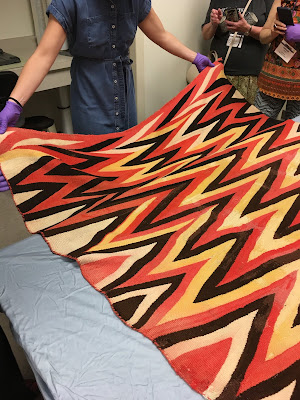Last weekend I spent three days immersed in wedge weave, in a class led by
Deborah Corsini at the
Intermountain Weavers Conference at Fort Lewis College in Durango, Colorado. It will be hard to capture all that we saw and did in that time in a brief post but I'll try.
Wedge weave is a particular type of eccentric weaving that was done for just a couple decades by Navajo weavers in the late 19th century. In wedge weave, you weave diagonal lines at an oblique angle to the warp, first in a band of diagonals slanting in one direction that goes across the width of the warp, then in a band of diagonals slanting in the other direction. This approach pushes the warps out of their vertical alignment and creates the distinctive scalloped edges that characterize wedge weave.
 |
| Deborah Corsini with her piece Rip Tide |
 |
Deborah holding her piece "Trail of Tears" that was included in the exhibit of work by leaders and IWC board members.
Notice the use of slits as design elements. |
One of the biggest treats of the workshop was the chance to see up close two Navajo wedge weave rugs held at the collection of the
Center of Southwest Studies at Fort Lewis College. Museum staff invited us behind the scenes to examine and photograph two historic rugs. It was thrilling to see how differently each weaver used the wedge weave technique.
While at first glance the design might seem simple, the more we looked, the more we found to see.
The second rug featured bands of plain (regular, perpendicular weave) between the bands of wedge weave. We also noticed that the dyes had faded and/or bled, but felt this did not hinder the appeal of the rug at all. In fact, in this second rug especially, the churro wool was incredibly lustrous (and hard to capture in the photograph.)
On the workshop's second day, Deborah shared an extensive PowerPoint lecture featuring the work of contemporary artists using wedge weave. It was exciting to see that what might appear at first to be a fairly straightforward technique has almost endless possibilities. Many artists, including Deborah herself, have truly found their own unique voices in this approach.
Before the workshop,
I had done a few pieces in wedge weave, but there were some stubborn technical questions I couldn't resolve, and I sensed that there was more I could learn. Deborah immediately solved the technical issues and in one-on-one conversations pointed me toward several possible directions to explore. For me wedge weave is a capacious and friendly format that can be abstract or representational (or both at once). It can be regular and geometric or delightfully irregular and organic, even nearly three-dimensional. I have found that when I have a wedge weave on the loom, that is often the piece I turn to first when I have time to weave. Hmmm. . .
Deborah shared that her teacher, Martha Stanley, said that "I now know that a technique in a sense chooses me, not the reverse." I have felt this too; I never expected to be a wedge weaver, but I find that I keep returning to it, for the handy structure it imposes and the improvisation that it encourages within the constraints of that structure. Right now I am seeing the world through a zig-zaggy lens!
Here are some of the samplers we wove in the workshop (apologies to those I was unable to get good photos of):
 |
| Nancy's piece |
 |
| Kristi's work |
 |
| Cindy's piece |
 |
| Carol's work |
 |
| Evelyn's work |
 |
| Toni's work |
 |
| Lyn's work |
Lyn Hart also had a piece in the art exhibit that incorporated wedge and eccentric weaving. Here is her piece
Polen Verde, a rendition of a desert tree that blooms in yellow and scatters pollen abundantly in her part of Arizona. The three green trees are done in wedge weave.
 |
| Lyn Hart, Polen Verde |
 |
| detail, Lyn Hart, Polen Verde |
 |
| My work, still in progress. I will end it with a couple bands of zigzags similar to those at the bottom of the piece. |
 |
| This piece, Color Field, by Deborah Corsini inspired me to experiment with feathers. |
Thank you, everyone at IWC that made this conference happen, and thank you, Deborah Corsini, for inspiring us to begin to explore the possibilities of wedge weave.
* This was Deborah's phrase as she summed up our workshop and I just loved the way it described the course of our journey up the warp.




































